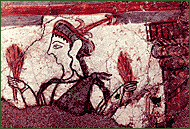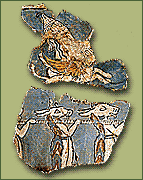The depiction of an imposing female figure which is often identified as the "Mother Goddess", the most significant deity of Minoan Crete, occurs frequently in Mycenaean iconography. The presence of this deity on mainland Greece as well as the identical way in which she is depicted show that the cult of the Minoan goddess of fertility was greatly approved by the agricultural populations of Mycenaean Greece. The various symbols that accompany the religious representations show that the Mycenaeans, as the Cretans, attribute many and various properties to the Mother Goddess. The shields present her as a war goddess while the animals and the birds she holds in her hands make her the Potnia, that is to say the goddess which was responsible for the birth and death of the animals. One of the most common emblems of the Mother Goddess was the snake. However, she is never depicted as a "snake goddess". In contradiction to this supreme female deity, the Mycenaean art does not include illustrations of male gods. This differentiates them from the god of Minoan Crete which is considered husband, son or attendant of the Mother Goddess and is less frequently but regularly depicted in Minoan art. There are also the demonical figures which were the attendants of the anthropomorph goddess, as the donkey-like demons which are depicted on a fresco of Mycenae and on the gold ring of Tiryns. One of the most common themes of Mycenaean religious iconography were the sphinxes, mythical figures of eastern origin with a lion body and female head which usually bear a feather crown. The similarities of the Mycenaean and Minoan religious iconography made the researchers believe that the Mycenaean beliefs were absolutely identical with the Minoan ones, the former being of eastern origin as well. But, the decipherment of the texts of Mycenaean writing revealed a rather different Mycenaean religion. Texts of the palace tablets include names of gods of the Greek twelve-god pantheon as Zeus, Hera, Poseidon, Artemis, Hermes and Dionysus while there is frequent reference to the Potnia, an early regional goddess which is identified with Athena. Along with these the cult of a number of unknown until then deities, whose importance seems to have faded in the later Greek world, was ascertained. Therefore, the pantheon of the Mycenaean period is now considered as a mingling of different elements which expresses the coexistence of the regional tradition with imported Minoan elements. The cult of deities of a different origin at the same time as well as the different rendering of the cult ritual in art show that the Mycenaeans adopted from the Minoan cult only elements that did not oppose to their own religious traditions. |
 |
|
|
Mycenae, cult centre.
Fresco fragment with female deity. |
||
 |
||
|
Mycenae, cult centre.
Fresco fragment with daemons. |
||